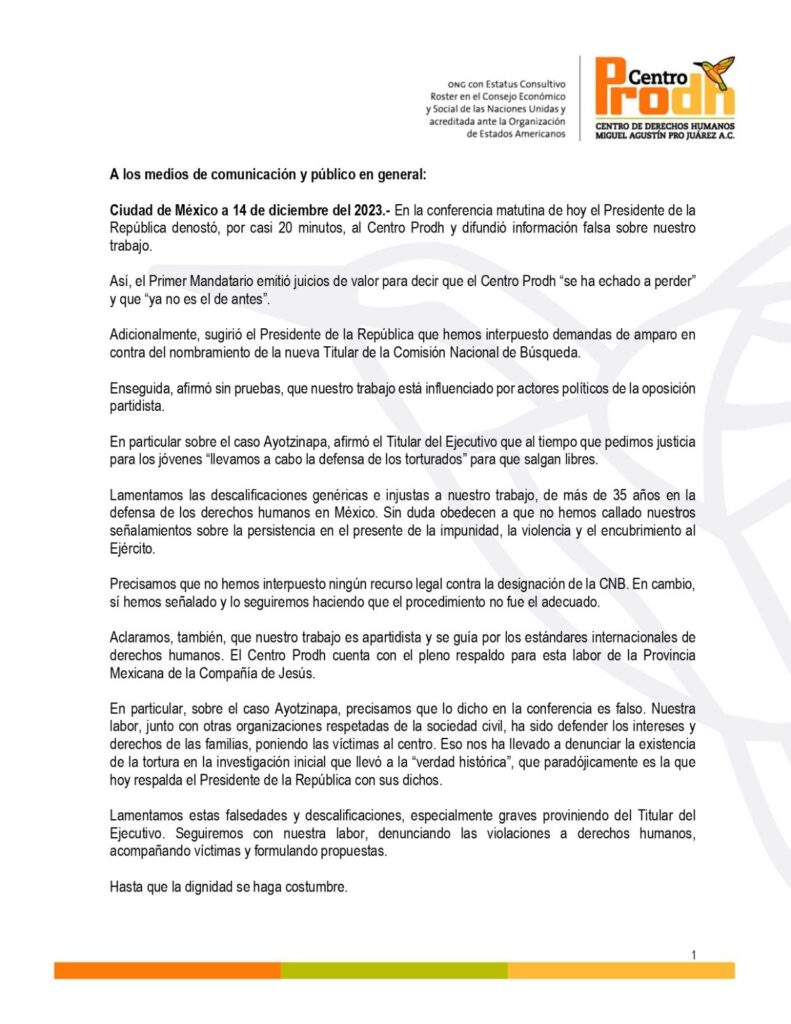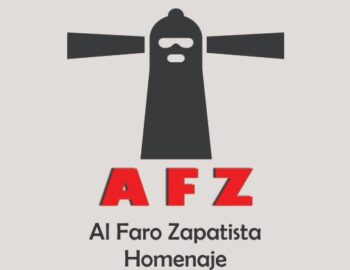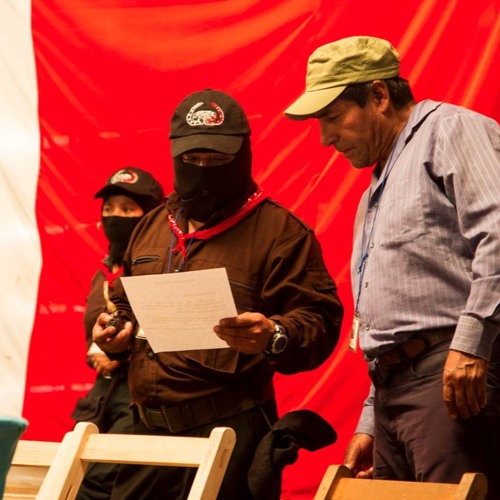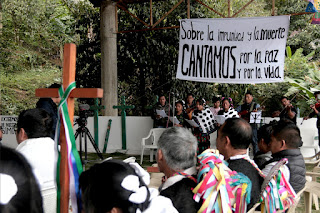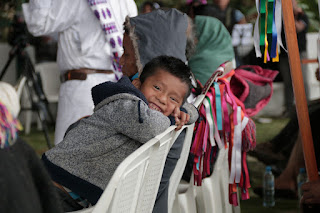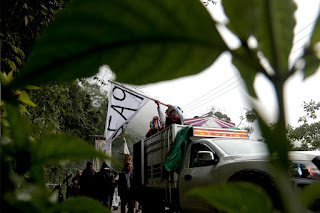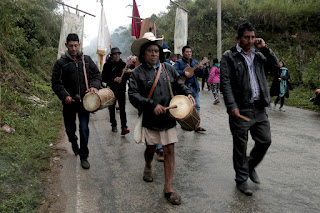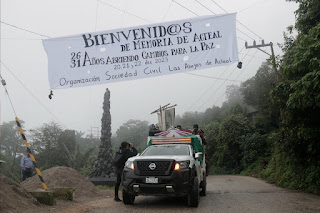Twentieth and Last Part: The Common and Non-Property
“Open wide your eyes, son, and follow the Pujuy bird. He is not wrong.
His destiny is like ours: to walk so that others do not get lost.”
Canek. Ermilo Abreu Gómez
On some past occasion, a few years ago, the Zapatista people explained to themselves the struggle “as the women that we are” pointing out, not a matter of mere will, disposition or study, but the material basis that made this change possible: economic independence of Zapatista women. And they were not referring to having a job and salary or the alms in coins with which governments across the political spectrum buy votes and memberships. They pointed to collective work as the fertile ground for this change. That is, organized work that was not intended for individual well-being, but for that of the group. It was not just about getting together for crafts, commerce, raising livestock, or planting and harvesting corn, coffee, and vegetables. Also, and, perhaps, above all, it was about their own spaces, without men. Imagine what in those times and places they spoke and speak among themselves: their pain, their anger, their ideas, their proposals, their dreams.
I will not go into more detail about it – the companions have their own voice, history and destiny. I only mention it because it remains to be known what is the material base on which the new stage that the Zapatista communities have decided will be built. The new initiative, as outsiders would classify it.
I am proud to point out that not only was the entire proposal the product, from its very conception, of the Zapatista organizational leadership collective- all of it of indigenous blood with Mayan roots. Also, that my work was limited to providing information that my bosses “crossed” with their own, and, later, to look for and argue objections and probable future failures (the aforementioned “hypothesis” to which I referred in a previous text). In the end, when they finished their deliberation and they specified the central idea, to submit it for consultation with all the peoples, I was as surprised as perhaps you will be now that you are going to know about it.
In this other fragment of the interview with Subcomandante Insurgente Moisés, he explains to us how they came to this idea of “the common.” Perhaps some of you can appreciate the deeply rebellious and subversive meaning of this in which, for the same reason, we risk our existence.
The Captain.
-*-
NON-OWNERSHIP.
Well, in summary this is our proposal: to establish extensions of the recovered land as common. That is, without property. Neither private, nor ejidal, nor communal, nor federal, nor state, nor business, nor anything. A non-ownership of land. As they say: “land without papers.” So, in those lands that are going to be defined, if they ask who owns that land or who is the owner, the answer will be: “nobody’s”, that is, they are “common”.
If you ask if it is the land of Zapatistas, or ‘partidistas’ or who, well, none of them. Or all of them, it’s the same. There is no commissioner or agent to buy, kill, disappear. What there is, is people who work and take care of those lands. And they defend them.
An important part is that, in order for this to be achieved, there has to be an agreement between the residents regardless of whether they are ‘partidistas’ or Zapatistas. In other words, they have to talk between themselves, not to bad governments. Seeking permission from bad governments has only brought divisions and even deaths among peasants themselves.
So, respecting the lands that are personal-family property, and those that are for collective work, this non-ownership is created on land recovered in these years of war. And it is proposed that it is worked together in shifts, regardless of what party you are, or what religion, or what color, or what size, or what gender you are.
The rules are simple: it has to be an agreement between the residents of a region. Do not grow drugs, do not sell the land, do not allow the entry of any company or industry. Paramilitaries are excluded. The product of the work of those lands belongs to those who work it in the agreed time. There are no taxes, nor payment of tithes. Each facility that is built is left for the next group. They take only the product of their work. But we will talk more about all this later.
This, very summarized, is what was presented and consulted with all the Zapatista towns. And it turned out that the vast majority agreed. And also that, in some Zapatista regions, it had already been done for years.
And what we did was, well, propose a path to cross the storm and reach the other side safely. And not to take that path alone as Zapatistas, but together as the indigenous peoples that we are. Of course, more will come out about this proposal: about health, about education, about justice, about government, about life. Let’s say that we see this as necessary to be able to face the storm.
TO THINK THE PATH AND THE STEP.
How did it get into our heads? Well, I’ll tell you. We saw several things. So this idea didn’t just come out at once. As if they came together and as if we saw it part by part and then everything together.
One was the storm. Everything that refers to the unconformity of nature. Its way of protesting, increasingly louder and increasingly terrible. Because we say destruction, but many times what happens is that nature kind of recovers a place. Or that it attacks invasions of the system: dams, for example. Tourist places, for example, that are built over the death of the coasts. Megaprojects that hurt, injure the earth. So, there comes a response. Sometimes it responds quickly, sometimes it takes a while. And the human being, well, what the system has done with the human being, is as if stunned. Does not react. Although he sees that misfortune is coming, that there are warnings, that there are alerts, he continues as if nothing had happened and, well, things do happen. They say that such misfortune was surprising. But it turns out that for several years now people have been warning that the destruction of nature is going to take its toll. Science, not us, analyzes it and proves it. We, then, as people of the earth see it. Everything is useless.
Misfortune does not suddenly appear in your house, no. First it gets closer, it makes its noise so you know it is coming. Knocks on your door. Breaks everything. Not only your house, your people, your life, but also your heart. You are no longer calm.
Another thing is what they call social decomposition, or as they say, the social fabric breaks, because of violence. In other words, a community of people is related to certain rules or norms or agreements, as we say. Sometimes written laws are made and sometimes there is nothing written, but nonetheless, people know. In many communities they say “act of agreement” that is, it is put into words. “This can be done, this cannot be done, this has to be done,” and so on. For example, whoever works advances. He who doesn’t work stays poor. That it is wrong to force someone to do something that he or she does not want to do, for example, in the case of men against women. That it is wrong to abuse the weak. That it is wrong to kill, steal, rape. But what happens if it’s the other way around? If evil is rewarded and goodness is persecuted and punished. For example, an indigenous farmer who sees that the destruction of a forest is wrong, then becomes its guardian. He protects the forest, therefore, from those who destroy it to make a profit. Defending is a good thing, because that brother or sister is taking care of life. That is humane, it is not religious. But it happens that this guardian is persecuted, imprisoned and, not infrequently, murdered. And if you ask what his crime is, why they killed him, and you hear that his crime was defending life, like brother Samir Flores Soberanes, then it is clear that the system is sick, that it no longer has a remedy, that you have to look elsewhere.
What does it take to realize this disease, this rottenness of humanity? You don’t need a religion, or a science, or an ideology. Just look, listen, feel.
And then we see that the big bosses, the capitalists, don’t care what happens tomorrow. They want to earn pay today. As much as possible and as quickly as possible. It doesn’t matter if you tell them: “hey, but what you do destroys and the destruction spreads, grows, becomes uncontrollable and returns to you. As if you were spitting up into the air or urinating against the wind. It comes back to you.” And you may think that it is good that misfortune happens to a scoundrel. But it turns out that, before that, it takes away quite a few people who don’t even know why. Like babies, for example. What will a child know about religions, ideologies, political parties or whatever. But the system holds those babies responsible. It makes them pay. It destroys in their name, it kills in their name, it lies in their name. And they inherit death and destruction.
So, it doesn’t seem like it’s going to get better. What we know is that it will get worse. And that, whatever happens, we have to cross the storm and get to the other side. Survive.
Another thing is what we saw on the Journey for Life. What is going on in those parts that are supposed to be more advanced, that are more developed as they say. We saw that all that talk about “Western civilization”, “progress” and things like that is a lie. We saw that there was what is necessary for wars and crimes. Now we actually saw two things: one is where the storm is headed if we don’t do anything. The other is what other organized rebellions are building in those geographies. In other words, those people look at the same thing that we look at. That is, the storm.
Thanks to these brother peoples we were able to broaden our vision, make it wider. That is, not only look further, but also look at more things. More world, that is.
So we, as indigenous peoples, ask ourselves what will we do, if it is already over, if it is every man for himself. But we see those brothers who act like they don’t care what happens to others, that they only look out for themselves, and then it reaches them anyway. They believe they are safe locked inside themselves. But that does not work at all.
THE ROAD OF MEMORY.
So we think, we remember how it was before. We talked about it to our elders. We asked them if it was like this before. We ask them to tell us if there has always been darkness, death, destruction. Where did that idea of the world come from? How come everything got fucked up. We think that if we know when and how the light, the good thought, the complete knowledge of what is good and what is bad was lost, then maybe we can find that and with that fight for everything to become complete, as it should be, respecting life.
And then we saw how that came to be and we saw that it came with private property. And it is not about changing the name and saying that there is ejidal property or small property or federal property. Because in all cases it is the bad government that gives the papers. In other words, it is the bad government that says if something exists and, with its trick, whether it ceases to exist. As it did with the reform of Salinas de Gortari and with the blows against communal property, which only existed if it was registered and that, with the same laws, they diminish it until it disappears. And communal property, let’s say registered, also causes divisions and confrontations. Because those lands legally belong to some, but against others. Property papers do not say “this is yours”, what they say is “this is not that person’s, attack him”.
And there you have the peasants going round and round to be given a piece of paper that says that what is theirs is theirs because they already work for it. And peasants waging war against peasants not even over a piece of land, no, it’s over a piece of paper that says who owns that land. And whoever has more papers, well, has more paid support, that is, more deception. Because it turns out that if you have a paper they give you a social program, but they ask you to support, for example, a candidate because that candidate is going to give you the paper and give you money. But it turns out that that same government is deceiving you, because it sells that paper to a company. And then it turns out that the company comes and tells you that you have to leave because that land is not yours because the ‘pinche’ businessman now has the paper. And you leave either willingly or forcefully. And there they have armies, police and paramilitaries to convince you to leave.
It is enough for the company to say that it wants such land, for the government to decree the expropriation of those lands and tells the company to do its business “for a while.” That’s what they do with megaprojects.
And all for a ‘pinche’ piece of paper. Although the paper is as old as New Spain, the paper is worthless to the powerful. It’s a hoax. It is so that you can trust and be calm until the system discovers that, beneath your poverty, there is oil, gold, uranium, silver. Or that there is a spring of pure water, and now it turns out that water is already a commodity that is bought and sold.
A commodity like your parents, your grandparents, your great-grandparents were. A commodity like you are, and your children, your grandchildren, your great-grandchildren will be, and so on for generations.
So the paper is like the labels of merchandise in the markets, it is the price of the land, of your work, of your descendants. And you don’t realize it, but you’re already lined up in line at the cashier and you’re going to arrive. And it turns out that not only are you going to have to pay, you are also going to leave the store and find that they have taken your merchandise, that you don’t even have the paper that you and your ancestors fought so hard for. And that maybe you will inherit a paper for your children, and maybe not even that. Government papers are the price of your life, you have to pay that price with your life. So you are a legal commodity. That’s the only difference with slavery.
Then the older ones tell you that the problem, the division, the arguments and the fights, came when the property papers arrived. It’s not that there weren’t problems before, it’s that they were resolved by making an agreement.
And the problem is that you can make many papers that split the earth many times, but the earth does not grow like the papers. A hectare is still a hectare, even if there are many papers.
Then what happens now with that thing they call ‘Cuarta Transformación’ and its “Sembrando Vida” program: in the ejidos there are the ‘right-holders’ – who are the ejidatarios who have the aforementioned paper of agrarian certificate -, and the ‘applicants’ who, although they participate in the community , they have no paper, because the land is already distributed. Supposedly, the applicants are requesting a piece of land, but in reality, they are requesting a piece of paper that says they are peasants who work the land. So, it is not that the government comes and tells them that such land is theirs. No. It tells them that, if they prove ownership of 2 hectares, they will be given financial support. But where do those 2 hectares come from? Well, from the ‘right-holders’.
In other words, the land that the paper says is one’s property has to be broken into pieces for the applicants. It has to be broken up so that there can be several papers of the same paper. There is no agrarian distribution, there is fragmentation of property. And what happens if the ‘right-holder’ doesn’t want to or can’t? His children want the financial support, but they need the paper. Then they fight with the father. The daughters? Not even taking into account, women do not count in the pieces of paper. And children fight to the death against parents. And the children win and with that paper, because the land remains the same and continues to be where it was, they receive their money. With that payment they go into debt, buy something, or get together to pay the coyote to go to the United States. Since they can’t afford it, they sell the paper to someone else. They go to work abroad and it turns out that they are earning to pay back those who lent them. Yes, they send remittances to their relatives, but their families use that to pay the debt. After a while, that child returns or is returned. That is if they don’t kill him or kidnap him. But he no longer has land, because he sold the paper and now that land belongs to the person who has the paper. So he murdered his father for a paper he no longer has. And then he has to find the payment to buy the paper again.
The population grows, but the land does not grow. There are more papers, but it is only the same area of land. What is going to happen? That right now they are killing each other between right-holders and applicants, but later they are going to kill each other between applicants. His children are going to fight among themselves, just as he fought against his parents.
For example: you are a right-holder with 20 hectares and you have, let’s say, 4 children. It is the first generation. You distribute the land or rather the paper and there is now a 5-hectare paper for each one. Then those 4 children have four other children each, second generation, and they distribute their 5 hectares and they get a little more than one hectare each. Then those 4 grandchildren have another 4 children each, third generation, and they divide the paper and each one gets about a quarter of a hectare. Then those great-grandchildren have 4 children each, fourth generation, and they divide the paper and they get a tenth of a hectare each. And I no longer continue, because just in 40 years, in the second generation, they are going to kill each other. That’s what bad governments are doing: they are sowing death.
THE OLD NEW ROAD.
What has what they say about “material base” been like in our history of struggle?
Well, first was the food. With the recovery of the lands that were in the hands of the large landowners, the diet improved. Hunger was no longer the guest in our homes. Then, with the autonomy and support of people who are “good people,” we say, health followed. Here the support of the fraternal doctors was and is very important, which is what we call them because they are like our brothers who help us not only with serious illnesses. Also, and, above all, in preparation, that is, in health knowledge. Then education. Then the work on the land. Then what is the government and administration of the Zapatista people themselves. Then what is government and peaceful coexistence with those who are not Zapatistas.
The material basis of this, that is, the form of production is a coexistence of individual-family work with collective work. Collective work made it possible for the colleagues to take off and participate in autonomy.
Let’s say that the first 10 years of autonomy, that is, from the uprising to the birth of the Juntas de Buen Gobierno, in 2003, were years of learning. The next 10 years, until 2013, were about learning the importance of generational change. From 2013 up to date it has been about verifying, criticizing and self-criticizing errors in operation, administration and ethics.
In what follows now, we will have a stage of learning and readjustment. In other words, we will have many errors and problems, because there is no manual or book that tells you how to do it. We will have many falls, yes, but we will get up again and again to continue walking. That is, we are Zapatistas.
The material base or production base of this stage will be a combination of individual-family work, collective work and this new thing that we call “common work” or “non-ownership.”
Individual-family work is based on small and personal property. A person and his/her family work their piece of land, their little store, their mobile phone, their livestock. The profit or benefit is for that family.
Collective work is based on the agreement between colleagues to do work on collective land (assigned before the war and expanded after the war). Work is distributed according to time, capacity and disposition. The gain or benefit is for the collective. It is usually used for parties, mobilizations, acquisition of health equipment, training of health and education promoters, and for the movements and maintenance of authorities and autonomous commissions.
The common work begins, now, in tenure of land. A portion of the recovered lands are declared as “common work.” That is, it is not parceled out and is not owned by anyone, neither small, nor medium, nor large property. That land belongs to no one, it has no owner. And, in agreement with nearby communities, they “lend” each other that land to work on. It cannot be sold or bought. It cannot be used for the production, transfer or consumption of narcotics. The work is done in “shifts” agreed upon with the GALs and the non-Zapatista brothers. The benefit or gain is for those who work, but the property is not, it is a non-property that is used in common. It doesn’t matter if you are Zapatista, ‘partidista’, Catholic, evangelical, Presbyterian, atheist, Jewish, Muslim, black, white, dark, yellow, red, woman, man, ‘otroa’. You can work the land in common, with the agreement of the GALs, CGAL and ACGal, by town, region or zone, who are the ones who control compliance with the rules of common use. Everything that serves the common good, nothing that goes against the common good.
A WORLDWIDE SHARING: THE TOUR FOR LIFE.
A few hectares of this Non-Property will be proposed to sister nations in other geographies of the world. We are going to invite them to come and work those lands, with their own hands and knowledge. What happens if they don’t know how to work the land? Well, the Zapatista comrades will teach them how, and the times of the land, and its care. We believe that it is important to know how to work the land, that is, to know how to respect it. I don’t think it hurts anyone that, just as they study and learn in laboratories and research centers, they also study and learn field work. And it is even better if these brother peoples have knowledge and a way of working the land and they bring us that knowledge and ways, and that is how we also learn. It’s like a sharing, but not just words, but in practice.
We do not need people to explain exploitation to us, because we have experienced it for centuries. Nor for them to come and tell us that we have to die to achieve freedom. We know that and have practiced it every day for hundreds of years. What is welcome is knowledge and practice for life.
Look, the delegation that went to Europe learned many things, but the most important thing we learned is that there are many people, groups, collectives, organizations that are looking for a way to fight for life. They have another color, another language, another custom, another culture, another way. But they have the same thing as us, which is the heart of struggle.
They are not looking for who is better, or to be given a place in bad governments. They are seeking to heal the world. And yes, they are very different from each other. But they are equal, or rather we are equal. Because we really want to build something else, and that thing is freedom. That is, life.
And we, the Zapatista communities, say that all of these people are our family. It doesn’t matter that they are very far away. And in that family there are older sisters, older brothers, little sisters and little brothers. And there is no one better. But same family. And as a family we support each other when we can, and we teach each other what we know.
And all, women, men and ‘otroas’ are people from below. Why? Because those at the top preach death because that gives them profits. Those at the top want things to change, but for their benefit, although it is getting worse and worse. That is why it is those below who are going to fight and are already fighting for life. If the system is one of death, then the fight for life is the fight against the system.
What comes next? Well, everyone builds their idea, their thinking, their plan of what is best. And each person perhaps has a different thought and a different way. And that must be respected. Because it is in organized practice where everyone sees what works and what doesn’t. In other words, there are no recipes or manuals, because what works for one may not work for another. The global “common” is the sharing of stories, of knowledge, of struggles.
In other words, as they say, the journey for life continues. That is, for the struggle.
From the mountains of the Mexican Southeast.
Subcommander Insurgent Moisés.
Mexico, December 2023. 500, 40, 30, 20, 10, 3, a year, a few months, a few weeks, a few days, just a while ago. After.
P.S.- At the end of the interview and after he had checked whether the meaning of his explanations was complete and correct, Subcommander Insurgent Moisés – who received command and the Zapatista spokesperson 10 years ago, in 2013 – lit the umpteenth cigarette. I lit the pipe. We stood looking at the lintel of the ‘champa’ door. Early morning gave way to dawn and the first lights of day woke up the sounds in the mountains of southeastern Mexico. We didn’t say more, but maybe we both thought: “and what’s missing is yet to come.”
P.S. WHICH DECLAREs UNDER OATH. – At no moment or stage of the deliberation that led to the decision made by the Zapatista peoples, did quotes or footnotes or references, even distant ones, come to light from Marx, Engels, Lenin, Trotsky, Stalin, Mao, Bakunin, Che, Fidel Castro, Kropotkin, Flores Magón, the Bible, the Koran, Milton Freidman, Milei, progressivism (if it has any bibliographical reference other than its ‘cagatintas’), Liberation Theology, Lombardo, Revueltas, Freud, Lacan, Foucault, Deleuze, whatever is fashionable or fashionable on the left, or any source from the left, right, or from the non-existent centers. Not only, I also know that they have not read any of the founding works of the isms that fuel the dreams and defeats of the left. For my part, I give unsolicited advice to those who read these lines: everyone is free to make a fool of themselves, but I would recommend that before starting with their nonsense like “the Lacandona laboratory”, “the Zapatista experiment”, and to categorize this in one sense or another, they think about it a little. Because, speaking of ridiculous, they have already been making a big deal for almost 30 years by “explaining” Zapatismo. Maybe you don’t remember now, but what’s left over here, in addition to dignity and mud, is memory. Sorry.

I attest
The Captain



